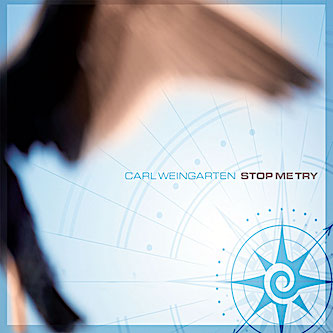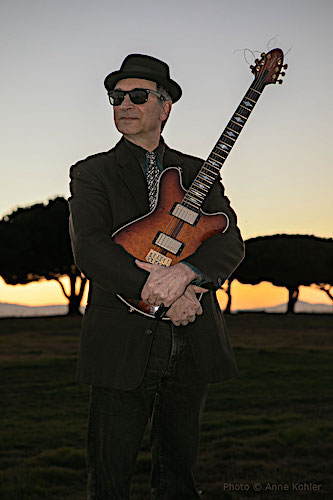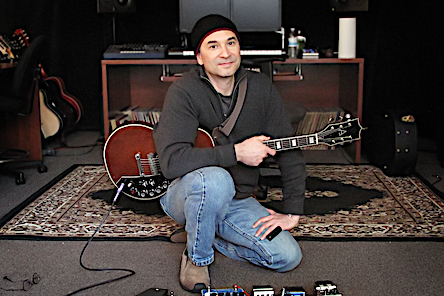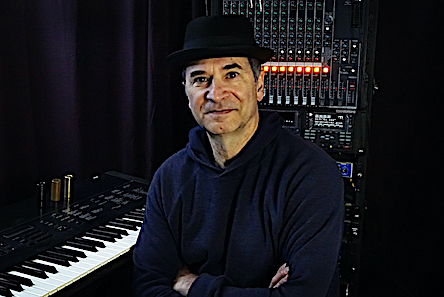 
|
||||
|
|
CARL WEINGARTEN |
|||
|
For those music fans following Carl since his early solo albums going all the way back to the late 1980s and even his very early 1980’s works with his band Delay Tactics, 2022’s Stop Me Try will arrive as a most welcome sonic revelation. The most obvious inclusion is the profusion of digital percussion which gives Stop Me Try a kind of sonic action running throughout the entire album. Although all the tracks benefit from the percussion sounds, one track in particular, track 2, “Ides Of May” appears to be lifted well off the ground and seems to fly into a sonic outer space all its own. Featuring multiple percussion tracks, “Ides Of May” sounds influenced by progressive rock imagery as well, although you would have to listen carefully to examine all the multiple musical overlays spilling out of your speakers. For an artist breaking new musical ground since 1980, Carl Weingarten continues making music history with his 2022 masterpiece Stop Me Try. www.CarlWeingarten.com
mwe3.com presents a new interview with
Carl Weingarten: Yes, I’d say Stop Me Try is a statement of defiance, but it’s really about the music and exploring new directions. It’s about living your life. mwe3: How does “A Fistful Of Dust” set the scene for Stop Me Try? It sounds like a song title from a Morricone soundtrack. “A Fistful Of Dust” and, in fact all of Stop Me Try has a kind of spaghetti western kind of feel to it, and that sounds like Charlie Bisharat on violin. Carl Weingarten: I’ve been a fan of Ennio Morricone’s music since I was a kid and saw the first two Clint Eastwood movies at a drive-in theater. The “Fistful Of Dust” melody is actually more middle eastern influenced than American western, but I was still going for a cinematic tone. Funny you mentioned Charlie Bisharat. I worked with Charlie in 1993 on a world music album produced by Kavi Alexander called At The Court Of The Chera King. It was a great experience. Charlie on the ‘Dust’ track would have been awesome, but the violin is someone else. mwe3: I would say “Ides Of May” is my favorite cut on Stop Me Try and in fact one of your best tracks ever. It’s really edgy and the percussion really takes it over the top. Tell us about the instrumentation on “Ides Of May”. Carl Weingarten: I’m glad you like the song. “Ides Of May” was actually the first piece I recorded for the album. I was experimenting with a bigger sound than my previous recordings. The track also plays with dynamics, having percussion and orchestral crescendos that resolve into reflective guitar breaks. And the percussion instruments change from one section to the next as well. mwe3: Speaking about the percussion on Stop Me Try, what instruments did you use to create the percussion? Is there real drums on Stop Me Try? Sure sounds like it on “Ides Of May” but there are so many bizarre sounds underneath. Carl Weingarten: Most are samples that were recorded by real drummers. I’m something of a pack-rat when it comes to loops, samples and sound effects. I have a library of material, a sonic tool chest, with samples I’ve collected over the years that I pull from. My original concept was to use digital percussion only as the foundation and then have Celso Alberti record live. Celso and I had a long conversation after he heard the rough mixes and he said basically, “The feel is there already. I’d end up changing it.” The feel he was talking about was the downtempo chill vibe that I was going for. And we agreed, as much as I love Celso’s playing, his sound would shift the music into jazz territory, and change the mood entirely. mwe3: Speaking of which, Stop Me Try sounds like one of your most overdubbed albums ever. Tell us about all the different percussion / drum sounds on Stop Me Try and if it’s your most percussion heavy albums to date.
mwe3: Another aspect of “Ides Of May” are the soaring synths. Tell us about the synth sounds on “Ides Of May” and elsewhere on Stop Me Try. I thought I heard a trumpet but I didn’t see trumpet listed on the one sheet. Are you sampling? Carl Weingarten: Some of the synths are my vintage DSS-1 or processed guitar or others or samples. The beauty of a large band is that each player makes a difference without having to fill the entire space. In “Ides” for example, the trumpet hit is a sample. It’s one note and I’m not sure it’s even in the same key as the song, but that doesn’t matter. It’s a statement, a hook, that reinforces the tone of the piece. mwe3: “Nightlife Again” is kind of ironic sounding. I was thinking it had a kind of Hank Marvin / surf guitar sound on it. Is it a hopeful track? It has a kind of discoid beat on it yet it’s pure instrumental guitar magic. Are you playing slide or ebow on “Night Life Again”? Are those octaves you’re playing around the 5 minute mark? Carl Weingarten: I was going for an ‘Out On The Town’ feel. The song was coming together last summer when Covid appeared to be lifting and things were opening up. The whole piece is very straight ahead, beginning with the guitar solo, which establishes the theme. But I wanted each solo thereafter to have a different feel, then come back to the main theme at the end. The guitars with the ‘60s western twang thing are double tracked in harmony. The synth and percussion are digital, and that’s Michael Manring adding that nice funky bass groove. There is no ebow on this tune. You're probably hearing amp feedback, which I like, and believe if applied with some coaxing is a very beautiful and expressive sound. Michael and I had a great day of recording. When I first asked Michael if he would do a session, I let him know that most of the tracks already had a synth bass of some kind, and asked if that would be an issue for him. He said he liked that the bass fundamentals were already covered leaving him to do the more creative work. So most of the songs actually have two bass parts. mwe3: How is “For Rosa” different from the prior tracks? Who is Rosa? It’s very mournful sounding and is a great showcase for your guitar work teamed with Michael Manring. Also tell us about that amazing sustain and echo around the 4:40 mark and that kind of lingers… Wow.
As for the song, I already had the bass and drums, but there was no guitar yet. I decided to play the guitar part in one sitting, not think about it, not plan, just go. That long passage that comes in at the end of the guitar solo is just one sustaining note, which starts to fade then turns around and ramps back up. It’s about letting go. mwe3: Tell us about the guitars and keyboards you play on Stop Me Try. Same guitar set-up as on Ember Days or is there some new gear, devices used to give it a different sound from your previous albums? Carl Weingarten: Same Sweetwood electric guitar and Blues Junior amp I’ve been using for several years. I think I swapped out a few pedals and pulled my old POD amp simulator to get a couple of the sounds, like the twang guitar sounds on “Night Life Again”. I’m not the gear-head I use to be. I have most of the tools I need to make the music I want. Music technology keeps advancing, and there’s great new pedals all the time, but I buy gear only if I know immediately what I’ll use it for. I just don’t have the space to store everything! mwe3: Do you think you will reach out to yet another audience with Stop Me Try? Rap lyrics and hip-hop never appealed to me much but I love the rhythms, percussion and trip-hop drumming and I must admit, it adds a kind of dance / movement element to the vibe. Carl Weingarten: I don’t hear “Stop Me Try” as a crossover piece, but new listeners are a blessing, always. The central beat in “Stop Me Try” is a downtempo thing. It has more of a roots feel than urban. I tried to changed it up as the song developed, but the arrangement too busy for what I was trying to accomplish. So I just kept the beat straight ahead. mwe3: Tell us about the Stop Me Try cover art. Was it designed by Tom Carlson and is it one of your photos? Looks like a bird and a compass. It’s more scaled back compared to Ember Days.
I couldn’t be happier with Tom’s design for Stop Me Try. I took the cover photo of the bird, which I sent him along with music and a few other images I liked. He took it from there. Check out his website. mwe3: I saw Jeremy Goody did the mixing / mastering again. Tell us something about the mixing and mastering process on Stop Me Try. I must admit it sounds great as intended. Carl Weingarten: Jeremy is a very talented and hardworking guy. He has a lot of experience and an extensive resume of bay area music production. With the last project, Ember Days, much of his work was refining my acoustic and electric guitar sounds. With Stop Me Try there was some of that, but a lot more digital and sampled material to work with. We spent a lot of time refining these various sounds into the mix. It’s one thing to compose with digitized material, but it’s another to make all these diverse elements sound like they belong together. mwe3: What do you think your fans will say and think about Stop Me Try? Sound like a good radio album as there’s so much percussion that it grabs your attention from all angles. Carl Weingarten: I just hope people enjoy the music. Stop Me Try took its own direction, and I like where it went. I’m satisfied when a song feels right to me, then I have to let it go. If the music resonates with listeners, then I can’t ask for more than that.
Carl Weingarten: I’m hopeful and staying busy. The last few weeks have been devoted to a pair of reissues that will include some material I’ve never had a chance to release before. Walt Whitney, David Udell and I have recorded a new Delay Tactics album. We’re very proud of it. The music has all the fun and experimental feel of our 1980’s albums, but with modern technology. You’re right, every week that goes by feels like a completely new world. By the time you publish this interview, who knows what we’ll all be dealing with. When Omicron finally subsides it will be a game changer, and we can truly walk and socialize freely again. I’m looking forward to that day...
|
|
|||
|
||||

 Bay-area guitar conceptualist Carl Weingarten released Ember Days in 2021 and in a prolific twist of fate, he returns in early 2022 with his latest and possibly greatest album called Stop Me Try. With 5 tracks, clocking in at a modest 33-minutes, Stop Me Try is nevertheless packed with copious sonic concepts that encompass guitar noir, hip-hop, New Age Jazz, some surf-guitar flecked passages and much more. Compared with Ember Days, which included a variety of accompanying musicians, Stop Me Try is mainly Carl in his studio with his long-time musical cohort Michael Manring. On an album that is equally entertaining and mesmerizing, Carl truly rises to the occasion on Stop Me Try performing on acoustic & electric guitars, slide guitar, keyboards and digital percussion.
Bay-area guitar conceptualist Carl Weingarten released Ember Days in 2021 and in a prolific twist of fate, he returns in early 2022 with his latest and possibly greatest album called Stop Me Try. With 5 tracks, clocking in at a modest 33-minutes, Stop Me Try is nevertheless packed with copious sonic concepts that encompass guitar noir, hip-hop, New Age Jazz, some surf-guitar flecked passages and much more. Compared with Ember Days, which included a variety of accompanying musicians, Stop Me Try is mainly Carl in his studio with his long-time musical cohort Michael Manring. On an album that is equally entertaining and mesmerizing, Carl truly rises to the occasion on Stop Me Try performing on acoustic & electric guitars, slide guitar, keyboards and digital percussion. mwe3: I guess everyone wants to know about the title meaning of Stop Me Try. I think people were, and still are, going through the pandemic with a kind of attitude that 'I’m invincible'. Is that the kind of thinking behind Stop Me Try?
mwe3: I guess everyone wants to know about the title meaning of Stop Me Try. I think people were, and still are, going through the pandemic with a kind of attitude that 'I’m invincible'. Is that the kind of thinking behind Stop Me Try?  Carl Weingarten: The song is track-heavy for sure. There’s a lot going on. The project was like starting a new band, only the band was digital. The pieces usually started with a beat that I liked or a simple groove. What I listened for is how inviting that sound is, or as Gale Ormiston would ask, “does it have promise?” Is it just a beat, or does it imply the beginning of something? That’s my cue to dig in. The pieces came together measure by measure, adding fills, effects, colors and melody to each arrangement.
Carl Weingarten: The song is track-heavy for sure. There’s a lot going on. The project was like starting a new band, only the band was digital. The pieces usually started with a beat that I liked or a simple groove. What I listened for is how inviting that sound is, or as Gale Ormiston would ask, “does it have promise?” Is it just a beat, or does it imply the beginning of something? That’s my cue to dig in. The pieces came together measure by measure, adding fills, effects, colors and melody to each arrangement. Carl Weingarten: Rosa was my cousin on my father’s side, who died of cancer last year. We were the same age and we had been close since childhood. Rosa was also an artist and musician and an excellent sax player. She grew up in Los Angeles and when I moved to California she helped me adjust to living here, the culture, the general vibe of California versus the Midwest.
Carl Weingarten: Rosa was my cousin on my father’s side, who died of cancer last year. We were the same age and we had been close since childhood. Rosa was also an artist and musician and an excellent sax player. She grew up in Los Angeles and when I moved to California she helped me adjust to living here, the culture, the general vibe of California versus the Midwest.  Carl Weingarten: Tom is a painter and a brilliant graphic artist. I’ve known Tom since my St. Louis days. When I first met Tom he was the art director of The Riverfront Times, the St. Louis version of the bay area Guardian, then later at The Village Voice and currently at The Phoenix Times. We hadn’t been in touch for many years, but we made the Facebook connection recently and began talking. At first it was mostly about our mutual friends and music back in the day, but I’d also call him for advice on design work and pretty soon he was offering to get involved.
Carl Weingarten: Tom is a painter and a brilliant graphic artist. I’ve known Tom since my St. Louis days. When I first met Tom he was the art director of The Riverfront Times, the St. Louis version of the bay area Guardian, then later at The Village Voice and currently at The Phoenix Times. We hadn’t been in touch for many years, but we made the Facebook connection recently and began talking. At first it was mostly about our mutual friends and music back in the day, but I’d also call him for advice on design work and pretty soon he was offering to get involved. 